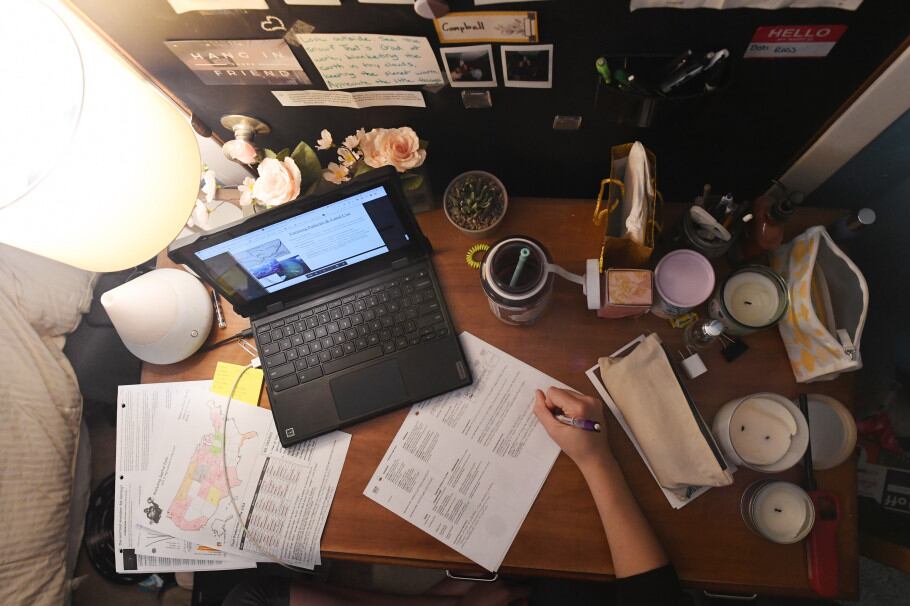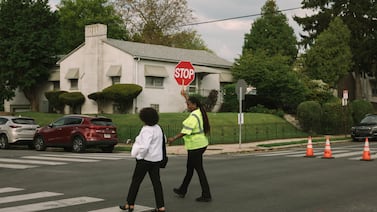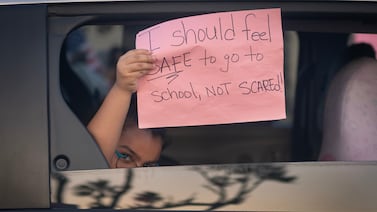On Monday, more than 100 family members called Denver’s Northfield High School — enrollment 1,550 — to say their children would be absent on Tuesday, the first day back to school after winter break. The reason? Their teenagers either had COVID, were exposed to COVID, or had COVID-like symptoms, Principal Amy Bringedahl said.
Five teachers called in sick for the same reasons, along with an assistant principal, the dean, the facilities manager, and the health aide. Later that day, the school’s relatively new on-site rapid COVID testing turned up a couple more teachers who were asymptomatic but positive.
By Monday evening, Bringedahl and her team had made the decision to switch to remote learning for two days. On Wednesday, they decided to extend Northfield’s building closure for two more days, until Friday. “I believe deeply in what we’re doing,” Bringedahl said. “If we can curtail it now, we have a much better chance of remaining in person.”
As one of the first schools in Denver to announce a switch to remote learning, Northfield may have been a bit ahead of the curve, due partly to the prescience provided by its rapid testing program. But the decision is one more schools are facing as the omicron variant sends COVID case counts soaring. On Tuesday, Denver Mayor Michael Hancock said that one in four people tested for COVID in Denver was positive, a staggering rate of 25%.
Though the vast majority of Denver’s 206 schools reopened for in-person learning Tuesday, at least 17 schools had announced full or partial shifts to remote learning Wednesday. Most shifts, whether they affect the entire school or a single grade level, are due to staffing shortages.
Denver principals are responsible for assessing whether they have enough staff to keep classrooms open. But a new policy instituted this fall says the superintendent must approve any full-school building closures, district spokesperson Scott Pribble said.
“We take the decision to switch to remote learning very seriously and we want to make sure that each decision is considered through the same lens,” Pribble said.
Superintendent Alex Marrero has repeatedly said he’s committed to keeping schools open for in-person learning as long as possible. In a Dec. 29 open letter, he called building closures “a last resort because we know how hard it is on families to shift to a remote day on short notice.”
At Northfield, students said the shift to remote learning Tuesday was disappointing but seamless. The most unsettling part was wondering how long the shift would last, and whether it would be a repeat of the “extended spring break” of March 2020 that turned into months of remote learning. Denver high schools didn’t reopen for in-person learning until January 2021.
“Planning ahead for the rest of the year, it’s like, should I be worried about this extending longer?” said Northfield High junior Hola Maka, 16. “Should I be planning for prom? Should I go buy my prom dress or should I buy more pajamas?”
In an email to families Wednesday, Bringedahl said the school doesn’t anticipate a long-term return to remote learning. However, she said her teachers are prepared to make short-term shifts on the fly. For the entire fall semester, Bringedahl said she told her staff every day to bring home everything they’d need to teach online. Northfield only had to go remote one other time, on a single day when 15 staff members were absent, Bringedahl said.
Other days, Northfield teachers covered for each other, giving up their planning periods to teach their colleagues’ classes when the school couldn’t find a substitute. If no teacher could cover, the school would combine classes, sometimes switching locations from a classroom to the library, which can hold more students, Bringedahl said.
That situation isn’t ideal for student learning or staff morale, Bringedahl said, and the possibility that Northfield would have to scramble this week played into the decision to go remote. Pivoting to online learning also allows students who would otherwise be absent to attend their classes virtually. Most absent students have mild COVID symptoms, are asymptomatic, or are healthy but quarantined and can still learn online, she said.
“That learning loss is significant for kids when they’re quarantined and can’t be in the classroom,” Bringedahl said. “Being remote provides them with that opportunity to continue with their learning.”
While the transition to remote learning went smoothly for Northfield this week, students said being online brought back feelings of despair and a lack of motivation.
“It’s back to the whole 2020 [thing] of cameras off, you don’t want people to see you,” said Northfield High senior Eduardo Hernandez, 18. Being in class Tuesday and Wednesday felt like “just hearing the teacher talk and their face and their voice” for the entire period, he said.
Senior Elliott Guinness, 18, said he was looking forward to seeing his friends in person this week but he’s not surprised that didn’t happen. His vaccinated mother is among the surge of people in Denver who contracted COVID over the winter break, he said.
“Once break actually started, it felt like a rush of people all at once got omicron and COVID,” Guinness said. “At a certain point, students and people my age feel like, ‘OK, I’m kind of over this. Let’s get back to normal.’ And then all of a sudden, it was like the beginning of COVID again.”
District and school officials are adamant that won’t be the case. In her email to families, Bringedahl said extending remote learning until Friday would allow all of the teachers and staff diagnosed with COVID this week and most of the quarantined students to return in person on Monday.
With its on-site rapid testing program, Northfield has more visibility into how COVID is circulating than most Denver schools. It’s the only district-run school participating in the state-sponsored program, which provides the staff to do the testing and pays students to participate: $25 for their first test and $10 for each subsequent one. The school also gets paid $2.50 for each test.
More than 800 students and staff enrolled in the program, which started at Northfield in mid-December. Of the more than 340 tests administered before winter break, not a single one turned up positive, said Melinda Pearson, the school’s communications specialist.
But on Tuesday, when the school opened up for staff and students to come get tested during remote learning, Pearson said 23 of the 209 tests were positive, a rate of 11%. Most of the students and teachers who tested positive were asymptomatic, she said.
Parent Tom Romero, whose son is a sophomore, said he’s thrilled that Northfield is offering rapid testing, and he was glad to see the school pivot to remote learning this week, though he agreed a prolonged switch would be difficult. Students said so too.
“I hope we go back to in-person [learning] next week,” said Maka, a student council member who enjoys the social interaction of school. “I’m hoping this isn’t another April of 2020.”







